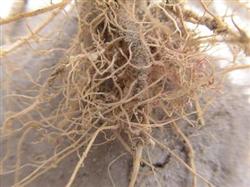Pay attention to the flowering disease of mung bean

At present, mung bean has entered the flowering and entrainment period, and diseases and insect pests have been found in some plots, among which mung bean leaf spot, virus disease, bacterial blight and soybean aphid are more harmful to mung bean. 1, mung bean leaf spot: the main harm to the leaves, there are light brown or dark brown disease spots on the leaves, there are obvious yellow circles on the edges, and in the later stage, several disease spots are connected into irregular large disease spots, with a diameter of 5-10 mm, high temperature and rainy weather, and the disease spot expands rapidly. the whole leaf was red and withered. 2. Mung bean virus disease: after mung bean was infected by virus in the field, the symptoms were mosaic and leaf shrinkage, plant dwarfing, and the transmission in the field was related to the number of aphids. Timely control of mung bean aphids and strengthening the management of water and fertilizer can reduce the incidence of the disease. 3. Prevention and control of blight. It occurred more seriously at 10-20 days after emergence, but lasted until the flowering and pod stage. In the early stage of the disease, reddish brown to dark brown disease spots appeared at the base of the seedling stem, and the cortex cracked and festered. In severe cases, the disease spot gradually expands and surrounds the whole stem, resulting in browning, depression, constriction and collapse at the base of the stem. Disease resistant varieties were selected. Mix seeds with 0.3% carbendazim wettable powder or 50% thiram wettable powder. Carry out crop rotation. At the initial stage of the disease, spray with 75% chlorothalonil wettable powder 600 times, or 50% carbendazim wettable powder 600 times. 4. Control Fusarium wilt. Also known as wilt disease. It often causes plant wilting and death. The leaves of seriously diseased plants gradually turned yellow from bottom to top, from yellow to withered, and finally dried up and fell off. Rotation for more than 3 years. In the early stage of the disease, the following drugs can be sprayed at the base of the stem every 7-10 days for 2 times: 800-1000-fold solution of 70% methyl thiophanate wettable powder, 600-fold solution of 70% chlorothalonil, and 1500-fold solution of 70% dichlorothalonil. 5. Aphids: mostly concentrated in the heart leaves of mung bean and the back of young leaves. After the injury, the bean leaves curled and the plant was short, which affected the flowering and pod formation. Key points of integrated control techniques integrated prevention and control of mung bean diseases and insect pests should be based on agricultural control, active promotion of biological control, and rational use of pesticides in critical periods. 1. Strengthen field management, deep ploughing after autumn, increase application of potassium fertilizer 2, protect and utilize natural enemies, make full use of natural enemies' natural control ability, and reduce the use of pesticides as much as possible. 3. Rational use of pesticides to control and control, to grasp two key periods, one is to carry out seed dressing in the sowing period, which has a better control effect on diseases in the seedling stage. Second, spraying at the flower and pod stage, starting at the early flowering stage, using 50% carbendazim 800x solution, adding 4.5% cypermethrin 50ml or 3% acetamiprid 10-15g, mixed with water 50-75kg, spraying once every 7-10 days, continuous control for 3 times can inhibit a variety of diseases and insect pests of mung bean.
- Prev

Measures for prevention and control of soybean diseases and pests
Soybean cyst nematode disease, commonly known as "Huolong Yangzi", is a destructive disease of soil-borne soybeans. The western part of our province is a serious area of the disease, with a yield reduction of about 10% in light cases, 30% to 50% in serious years, and even no yield in serious years. Soybean cyst nematode is mainly harmful to soybean roots, stunted plants, dwarf and seedling sensation.
- Next

Main diseases and control methods of mung bean
Mung bean cultivation can not use chemical fertilizer as fertilizer, for nitrogenous fertilizer is more important to avoid. Moreover, before the rain can not be sown, sowing seedlings should be uniform, this sample can ensure balanced nutrition. The field should be checked in time, the areas lacking seedlings should be replanted in time, and the seedlings should be fixed at 4-leaf stage. In barren plots, every seedling stage.
Related
- The first cup of black tea in spring, the flavor and history of tea gardens in Kenya, Africa
- The computer can not only choose potatoes, but also grow tea rice. AI will grow winter oolong tea champion.
- It is not only the inflated tea bitten by insects, but also engraved with the four seasons tea in Beipu.
- The Oriental Beauty Tea Festival in Zhuxian County takes the stage at the weekend to experience the plus-size feast of oil tea.
- & quot; Oriental Beauty Tea & Exploration of Emei in Hsinchu, the hometown of quot;
- The new variety of strawberry "Tainong 1" dessert is the first choice with mellow aroma. Crimson gorgeous
- History of Tea in Taiwan: from Wild Inner Mountain to Export Tea Garden
- Two types of Taiwan Oriental Beauty Black Tea won the British three-Star Award for Childhood Tea Xiang Zhang Jiaqi changed from pilot to champion tea maker.
- Banana species and varieties: the planting history of Taiwan Xianren banana and dwarf banana is long, is banana disease resistant?
- Coffee planting Technology: Qianjie Coffee from Seedling to harvesting

